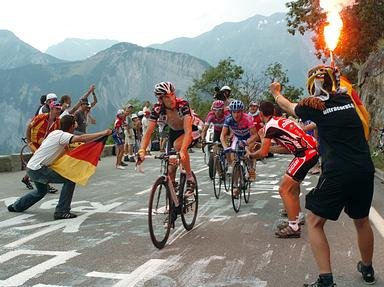Quiz Answer Key and Fun Facts
1. In the second edition of 1904, Henri Cornet finished the Tour de France in fifth place. Four months later Cornet was declared the winner, after the four riders ahead of him were disqualified. On what grounds were they disqualified?
2. The 1910 edition was the first to include true mountains, with a gruelling stage of 326 kilometers over the Col d'Aubisque and the legendary Tourmalet. Half walking and pushing his ungeared bike over mule tracks, which famous words did the later overall winner Octave Lapize, say to the officials upon reaching the summit?
3. In 1913, this rider had a comfortable lead and was well on his way to win the Tour de France, when in the nocturnal descent of the Tourmalet, the front fork of his bike broke. Repairs took hours and would cost him the race. Who is this tragic would-be champion?
4. In the oppressive heat of the summer of 1950, Marcel Molines and Abdel-Kader Zaaf, two French riders of Algerian descent, attacked the peloton with 200 kilometers to go. Molines went on to win the stage, but it was Zaaf who gained eternal fame. Why?
5. In 1951, Dutchman Wim "The Locomotive" van Est fell 70m (210 ft) into a ravine whilst descending de Col d'Aubisque. A crying Van Est was hoisted up with the aid of several spare tires tied together. Although he was relatively unscathed, he was forced to abandon the Tour. If surviving this crash was not enough, what made Van Est especially endearing to the fans?
6. This Tour de France legend and crowd favorite was unfortunate enough to be a contemporary of first Jacques Anquetil and later Eddy Merckx (both with 5 overall victories under their belt). Although he stood on the final podium an impressive eight times and managed a top ten finish in 11 of his 14 participations, he never actually won the Tour de France. Amazingly enough, he never even got to wear the yellow leader's jersey for a day! Who is this rider, nicknamed "L'Eternal Second"?
7. The Tour of 1989 is generally considered as one of the most exciting editions. On the very last day, the race leader had to defend a healthy 50 second lead in an individual time trial over 25 km in the streets of Paris, but failed miserably. After 3285 km of racing, which rider cruelly lost the race by a margin of only 8 seconds?
8. In 1999, Giuseppe Guerini, a teammate of German Tour winner Ullrich, seemed on his way to claim the biggest victory of his career, when a German supporter trying to take a last ditch photo, haplessly blocked his way. Guerini crashed with only 2 km to go and almost lost the stage. In which famous town did the stage finish that day?
9. Four riders actually died while participating in the Tour de France. Adolphe Hélière (1910) and Francisco Cepeda (1935) were the first two casualties. Who were the other two riders?
10. One day after losing the potential overall victory in a demanding mountain stage in the Tour of 2006, this rider astonished the cycling world in what was hailed as "one of the finest stages in modern Tour de France history". In a gutsy solo move of 128 km over five climbs, he clawed back lost time over all his competitors and went on to win the Tour. Unfortunately, one week after the Tour it came out that he had failed a drug test and was stripped of his title. Who was this "Amish Boy"?
Source: Author
Debarrio
This quiz was reviewed by FunTrivia editor
Nightmare before going online.
Any errors found in FunTrivia content are routinely corrected through our feedback system.
